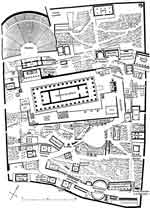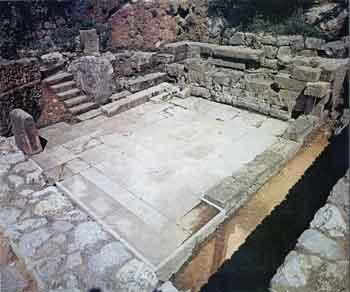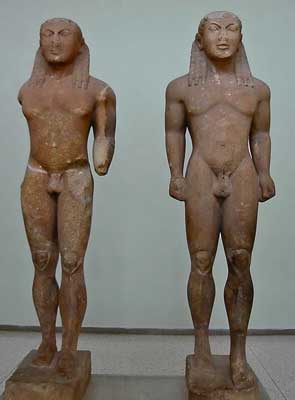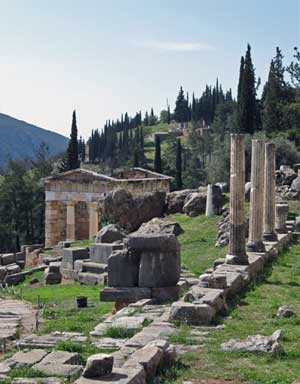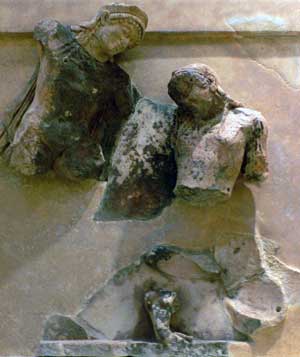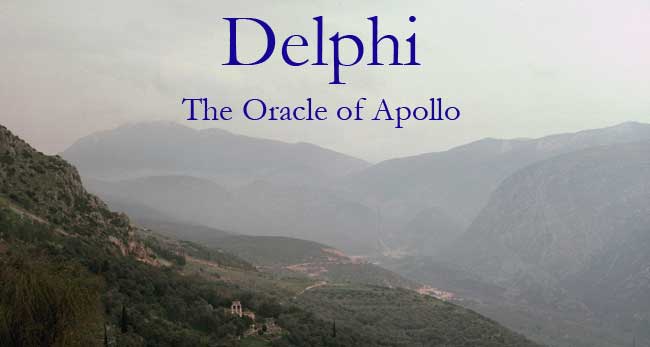
The Sacred Way
The Castalia Spring
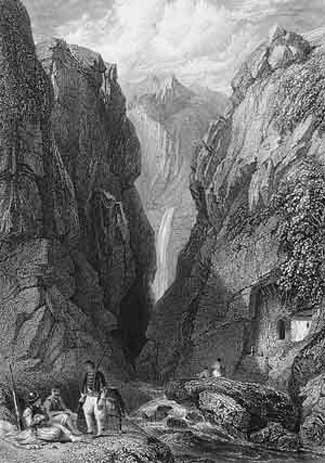 All visitors had to purify themselves at the Castalia Spring before entering the sanctuary . Generally this only involved washing the hair but those carrying blood-guilt had to bathe completely.
All visitors had to purify themselves at the Castalia Spring before entering the sanctuary . Generally this only involved washing the hair but those carrying blood-guilt had to bathe completely.
The water flows down through a narrow ravine where the two cliffs known as the Phaedriades come together and issues forth at about the same level as the entrance to the sanctuary but approximately 200 metres to the east. The cold, clear water was very pleasant to drink, according to Pausanias, and was widely believed give poetic inspiration. The waters were collected in a long, narrow cistern cut into the rock and gushed forth from seven bronze spouts in the shape of lion’s heads. The illustration (left) shows the ravine with the stream flowing down from the cliffs. The niches on the right cliff face were probably designed to hold votive offerings to the nymph Castalia and belong to the Hellenistic/Roman fountain house.
There was an earlier cistern lying about 50 metres further down the ravine. It was discovered by chance in 1958 when the main road was widened and has subsequently been restored. The archaic cistern was fed by a rock-cut channel and measures approximately 6.5 x 1.5 metres. It was built out of poros blocks and coated with plaster. Four spouts fed the water into the a paved court approached by a set of steps and lined with benches.
Dedications
The ceremonial entrance to the walled enclosure is in the eastern corner but there were secondary ones, aligning with the streets of the ancient town, at various points. In Roman times, there was a 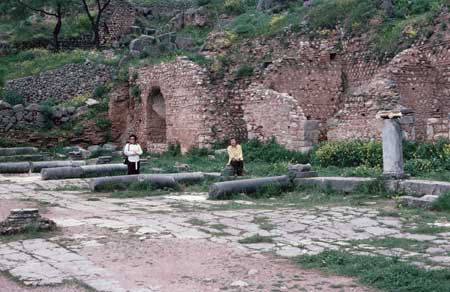 large open marketplace (agora) just outside the main entrance. Along northwest side ran a long stoa (left), a columned portico, offering rest and shade to the visitor, with five shops at the rear. The columns have been re-erected shortly after this picture was taken in 1977. There were similar stoas along the northeast and southeast sides as well, but these have not survived.
large open marketplace (agora) just outside the main entrance. Along northwest side ran a long stoa (left), a columned portico, offering rest and shade to the visitor, with five shops at the rear. The columns have been re-erected shortly after this picture was taken in 1977. There were similar stoas along the northeast and southeast sides as well, but these have not survived.
Once through the gate, the Sacred Way runs on a gently curving course upwards and towards the southern corner of the precinct where it takes a sharp bend to the right and continues up to the temple terrace. All along the route and on both sides were placed dozens of memorials, large and small, set up by individuals, by cities and by kingdoms. The majority of them commemorated famous victories—either on the battlefield or at the Games and normally took the shape of one or more 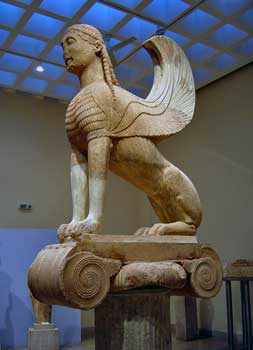 statues. Pausanias speaks of some 3,000 statues on the site—even after the depredations of Sulla and Nero—and it is mainly due to his descriptions that we know much about any of them. Many were smashed and destroyed by Christian iconoclasts while others, made of bronze or even gold, have long since been melted down as scrap. What remains on the site today are the bases. The Bronze Charioteer is a unique instance of the survival of a large-scale bronze statue. Marble stands a slightly better chance of survival and a number of these have been found, most notably a pair depicting the heroic brothers, Cleobis and Biton of Argos. Just beneath the temple stood a tall column with the statue of a seated sphinx (right) at the top, dedicated by the islanders of Naxos in about 560 BC. The Spartans established a major monument, which included 38 bronze statues, to commemorate their great naval victory over the Athenians at Aegospotomi in 405 BC at the start of the Sacred Way while the Athenians had their great monument, a porticoed stoa, at the finish.
statues. Pausanias speaks of some 3,000 statues on the site—even after the depredations of Sulla and Nero—and it is mainly due to his descriptions that we know much about any of them. Many were smashed and destroyed by Christian iconoclasts while others, made of bronze or even gold, have long since been melted down as scrap. What remains on the site today are the bases. The Bronze Charioteer is a unique instance of the survival of a large-scale bronze statue. Marble stands a slightly better chance of survival and a number of these have been found, most notably a pair depicting the heroic brothers, Cleobis and Biton of Argos. Just beneath the temple stood a tall column with the statue of a seated sphinx (right) at the top, dedicated by the islanders of Naxos in about 560 BC. The Spartans established a major monument, which included 38 bronze statues, to commemorate their great naval victory over the Athenians at Aegospotomi in 405 BC at the start of the Sacred Way while the Athenians had their great monument, a porticoed stoa, at the finish.
Other notable landmarks encountered along the way to the temple included the Rock of the Sibyll, an ancient boulder where it was believed that the site’s original oracle dispensed her prophecies, and the Rock 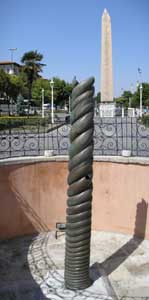 of Leto, where Apollo’s mother once rested. In front of the Stoa of the Athenians was a circulararea known as the Halos (“threshing floor”).
of Leto, where Apollo’s mother once rested. In front of the Stoa of the Athenians was a circulararea known as the Halos (“threshing floor”).
At the top of the terrace, directly opposite the entrance to the temple, stood the golden Tripod of Plataea, set up by the Greek states that had defeated the Persian invaders in 479 BC. According toHerodotus,
When the booty had been gathered together, a tenth of the whole was set apart for the Delphiangod, and, from this, was made the golden tripod which stands on the three-headed bronze serpent nearest the altar.
The golden tripod was stolen by the Phocians during the Third Sacred War (357-346 BC) and the three-headed bronze serpent was one of the many items gathered up from all over the empire by Constantine the Great for his new capital at Constantinople. He used it to decorate his great race-track, the Hippodrome (left). Behind it stands a large base which originally supported a gilded chariot dedicated by the islanders of Rhodes at the end of the fourth century BC.
The Treasuries
Dedications and memorials were good advertising for the city-states of ancient Greece and soon became a rather competitive business. Many of the items were too valuable (and too portable) to display on a regular basis and were only brought out for special occasions. For the rest of the time they were stored in the numerous treasuries that were built by the various cities and federations. The buildings are generally rather small but still left plenty of scope for extravagant display. Treasuries have been identified for all of the major centres of the Greek world, from Syracuse and Tarento in the far west to Poteidaia in the north. All were thoroughly plundered in antiquity.
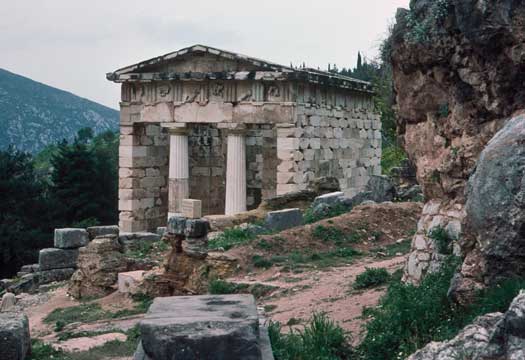
The reconstructed Treasury of the Athenians
The Treasury of the Athenians was restored by the French, in cooperation with the city of Athens, at the beginning of the last century (1904-6) and gives the visitor a pretty good ides of the appearance of the type. According to the inscription on the base, it was erected in the aftermath of the Battle of Marathon (490 BC) out of the spoils taken from the Persians. Measuring 9.7 x 6.62 metres it was built out of Parian marble, the finest available, and according to the principles of the Doric Order. There were two columns in antis supporting a small porch along with an entablature that included a series of 30 metopes depicting episodes from the Labours of Herakles and the Labours of Theseus.
The the best preserved and most ornate treasury was that of the Siphnians who lived on one of the Cycladic Islands. It belonged to the Ionic Order and can be dated to some time in the mid fifth century BC, when the island, thanks to its gold and silver mines, was at the peak of its prosperity. It was plundered by refugees from Samos in 525 BC so it is unlikely to have been built after that date. Instead of columns, the porch used a pair of caryatid statues to support the roof and the entablature was carved with one continuous frieze, nearly 30 metres in length.
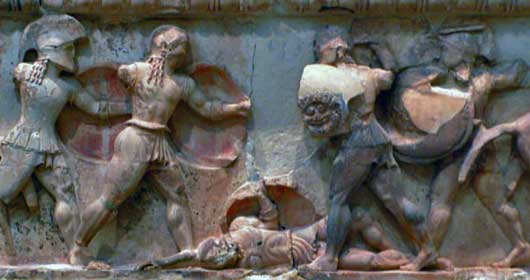
Treasury of the Siphnians. Frieze depicting an episode from the Trojan War
The main theme of the frieze on the eastern side of the building is the Trojan War. The example above shows Aeneas and Hector battling Menelaus and Ajax over the body of a dead warrior. The western side depicts the Judgement of Paris while on the northern side is the Gigantomachy, the war between the gods and giants. Below we see Artemis and Apollo shooting arrows at three giants wearing hoplite armour while a fourth turns to flee.
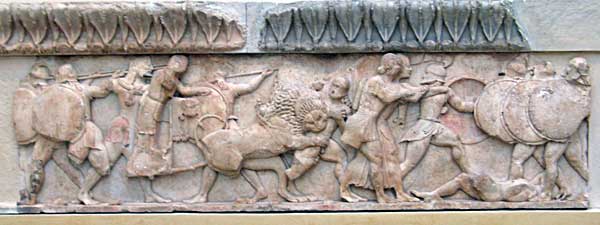
Treasury of the Siphnians. Frieze depicting the battle between the gods and giants (Gigantomachy). Photo ©Yair-haklai
There were a number of other buildings located along the Sacred Way, including the Bouleuterion, located next to the Treasury of the Athenians, where the fifteen members of the council who ran the affairs of the sanctuary met. Further along, up against the eastern wall of the precinct, was the Prytanion where the magistrates met and deliberated.

